Japan has long been known for its unique culture, cutting-edge technology, and thriving economy. However, behind these positive traits lies a looming crisis that has been quietly growing for decades: a rapidly declining population. With a fertility rate that has been consistently below the replacement level for nearly half a century, Japan has been facing a demographic time bomb that is now reaching a critical point. This is crucial for maintaining economic vibrancy and fiscal capabilities to manage its $8.47 trillion government debt.
In this article, we will explore the current state of Japanese population dynamics, and whether the country has passed the point of no return. We will examine the trends and demographics prior to the pandemic, as well as how the pandemic has affected the population. Additionally, we will investigate how Japan differs from other countries with shrinking populations and what this means for the future. Looking forward to 2050, we will analyze the projected population demographics and discuss what impact this will have on the Japanese economy. Finally, we will consider whether there are any potential solutions that can mitigate the effects of Japan’s shrinking population.
Population Trends and Demographics Prior to the Pandemic
Prior to the COVID-19 pandemic, Japan was already facing significant demographic challenges. With a low birth rate, an aging population, and declining immigration, the country was struggling to maintain its workforce and economic growth. Total Japanese population reached a peak of 128.13 million persons in 2010, before starting to decline (Figure 1). While the growth rate averaged 0.62% during 1961-2010, the population shrank by an average rate of 2.0% between January 2011 and January 2020. Not only has the population been declining prior to the pandemic, but it has been doing so at an increasing pace. Population growth rate dropped from an average of negative 0.14% during 2011-2017 to an average of negative 0.35% up to January 2020.
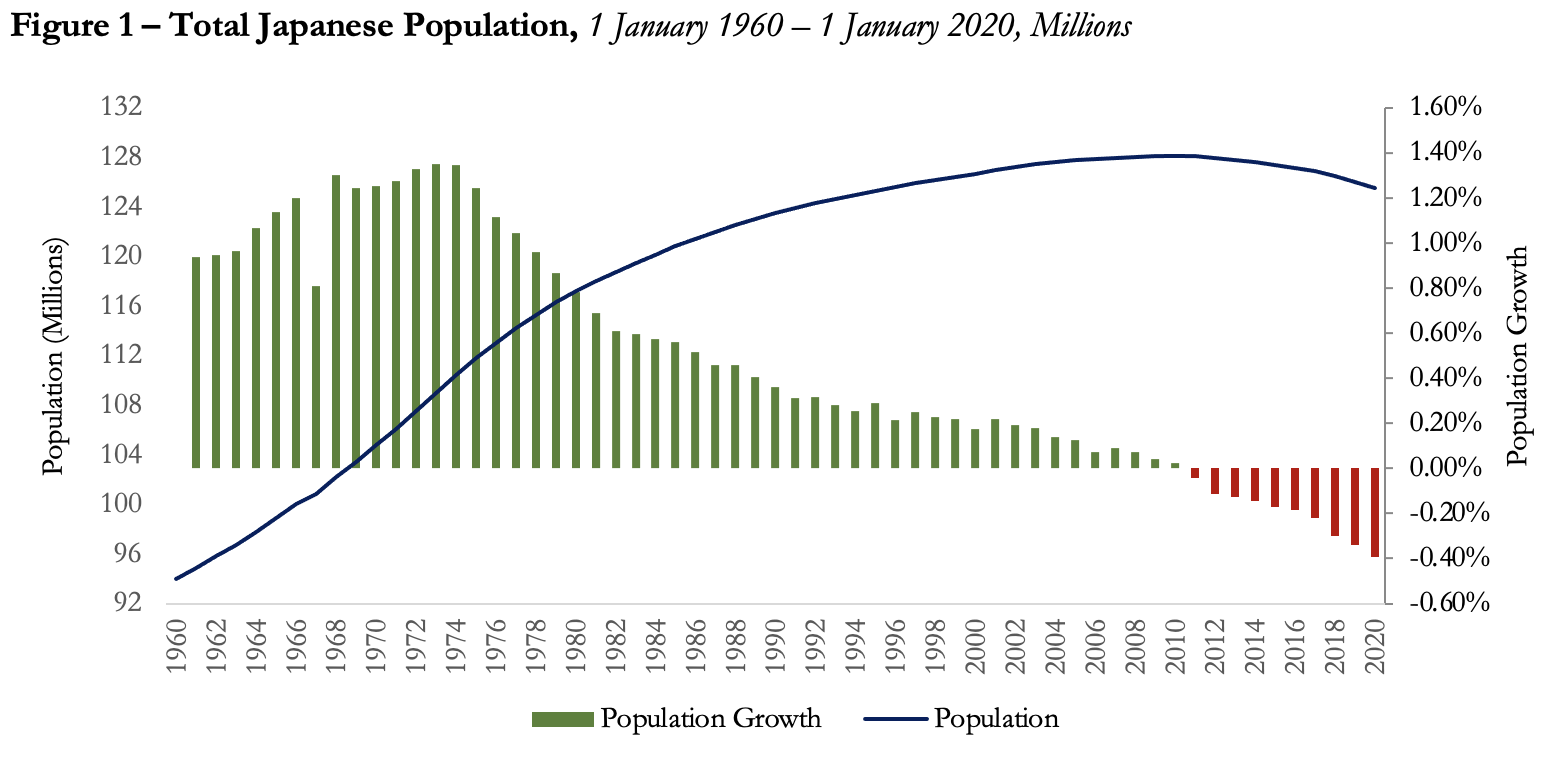
Source: United Nations 2022 World Population Prospects.
Owing to the high negative population rate, Japan is among the countries with the most rapid population declines. In 2021, Japan was the 24th country by population decline, following a number of other small countries and islands, as shown in Figure 2 below.
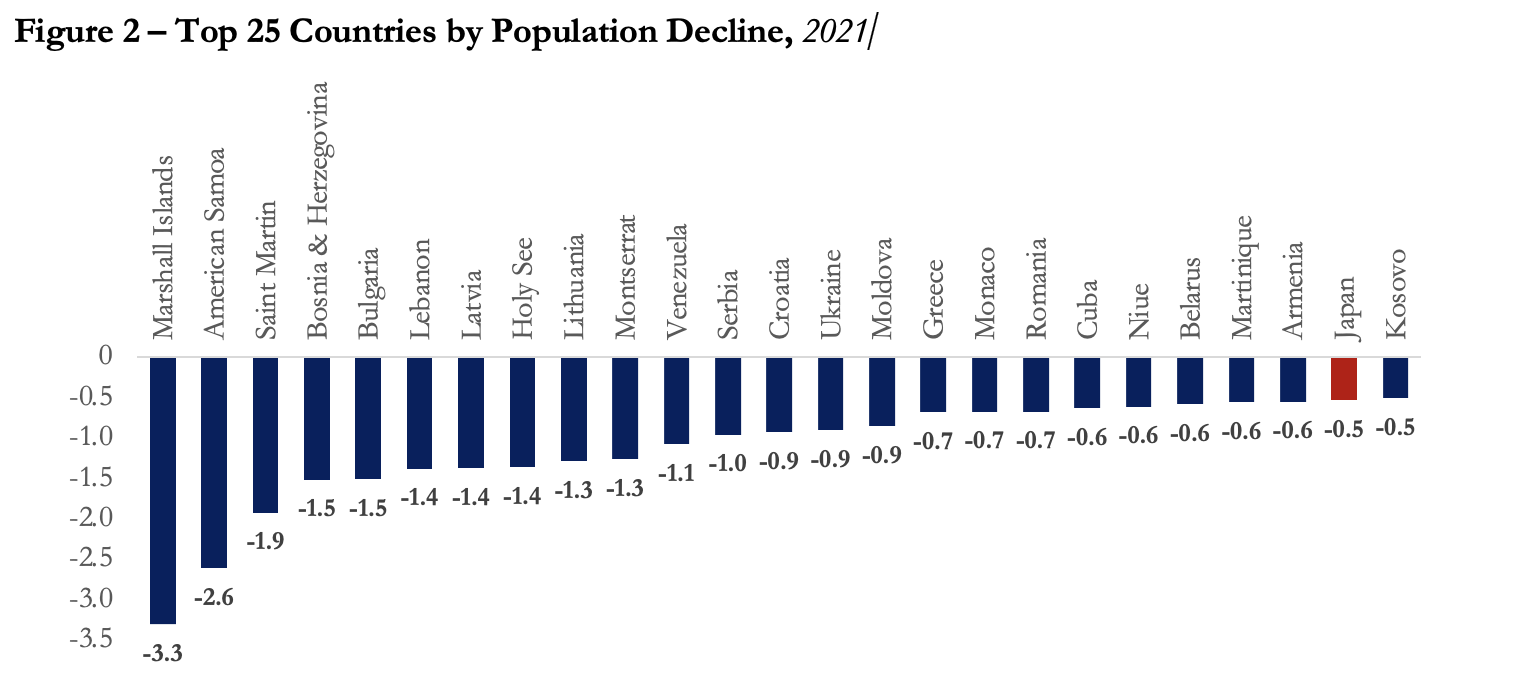
Source: United Nations 2022 World Population Prospects.
Population decline in Japan has been fueled by declining annual births, coupled with a higher number of deaths, as shown in Figure 3. The number of births almost halved from 1.66 million in 1960 to 0.84 million in 2019. On the other hand, the number of deaths doubled from 0.70 million to 1.52 million during the same period. While the number of births had exceeded deaths prior to 2005, the latter have surpassed births since then, leading to a negative natural rate.

Source: United Nations 2022 World Population Prospects.
Indeed, the declining Japanese population has been fueled by a negative natural change rate, measured as the difference between births and deaths, in addition to an insufficient net migration rate (Figure 4). While the net migration rate into Japan was able to offset a negative natural change for a few years, as the former remained more or less stable at no more than around 1.0 net migrants per 1000, it was only a matter of time before the rapidly declining natural change started pulling down the population. Natural change dropped from 9.87 per 1000 in 1960, to 1.53 in 2000, and negative 5.41 in 2019.
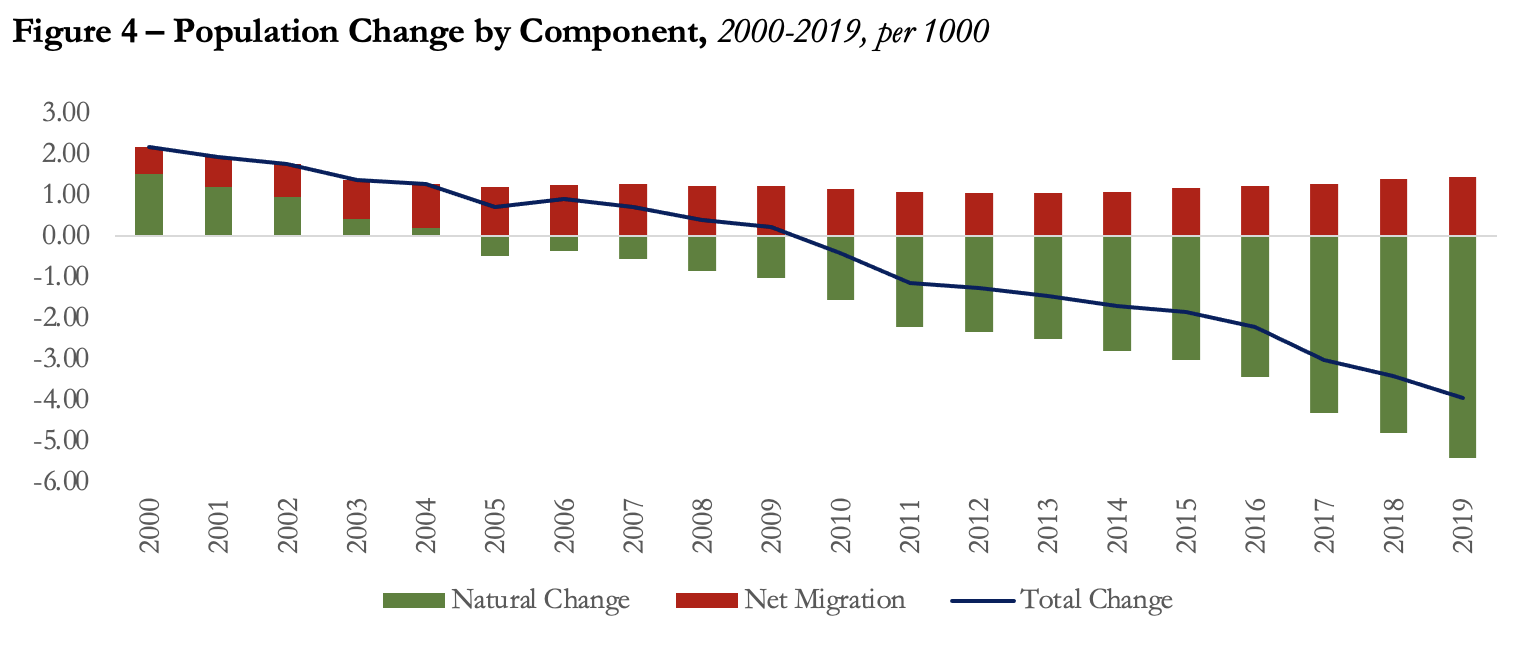
Source: United Nations 2022 World Population Prospects.
Figures 5 and 6 below summarize the key Japanese population and age demographics in 2019, compared to the European Union (EU) and World averages. Japan is obviously characterized by a low fertility rate, which stood at 1.3 live births per woman in 2019, almost half the 2.4 global fertility rate and even lower than the EU average of 1.5. Japan has one of the highest life expectancies in the World, at 84.6 years (compared to around 80.4 in the EU). This, in addition to the low fertility rate, has led to an aging population and a low crude birth rate of 6.7 births per 1000, which failed to surpass the 12.1 crude death rate. Looking at the Japanese age profile, the proportion of those 65 years of age or older is almost triple the world share, standing at 29.3% and 9.2%, respectively. Similarly, Japan has a median age of 47.6, compared to only 29.5 globally.

Source: United Nations 2022 World Population Prospects.

Source: United Nations 2022 World Population Prospects.
Moreover, with such an aging population and limited fertility, the old-age dependency ratio (defined as the percentage of those 65 years and above to the working-age population between 15 and 64 years) has been rapidly increasing over the years, from 9.0% in 1960 to 26.3% in 2020, finally hitting almost 50% in 2019 (Figure 7). This share is almost 3.5 and 1.6 times the global and EU averages, respectively.

Source: United Nations 2022 World Population Prospects.
Population Demographics During and After the Pandemic
The Japanese population has declined at an even higher rate during the COVID-19 pandemic, as shown in Figure 8 below. Population shrank at a rate of -0.47% and -0.53% during 2020 and 2021, respectively, compared to an average of -0.35% in the three years leading up to the pandemic. Total population stood at 124.3 million on 1 January 2022, down from 125.5 million on 1 January 2020, losing a total of 1,264 thousand people during those two years.
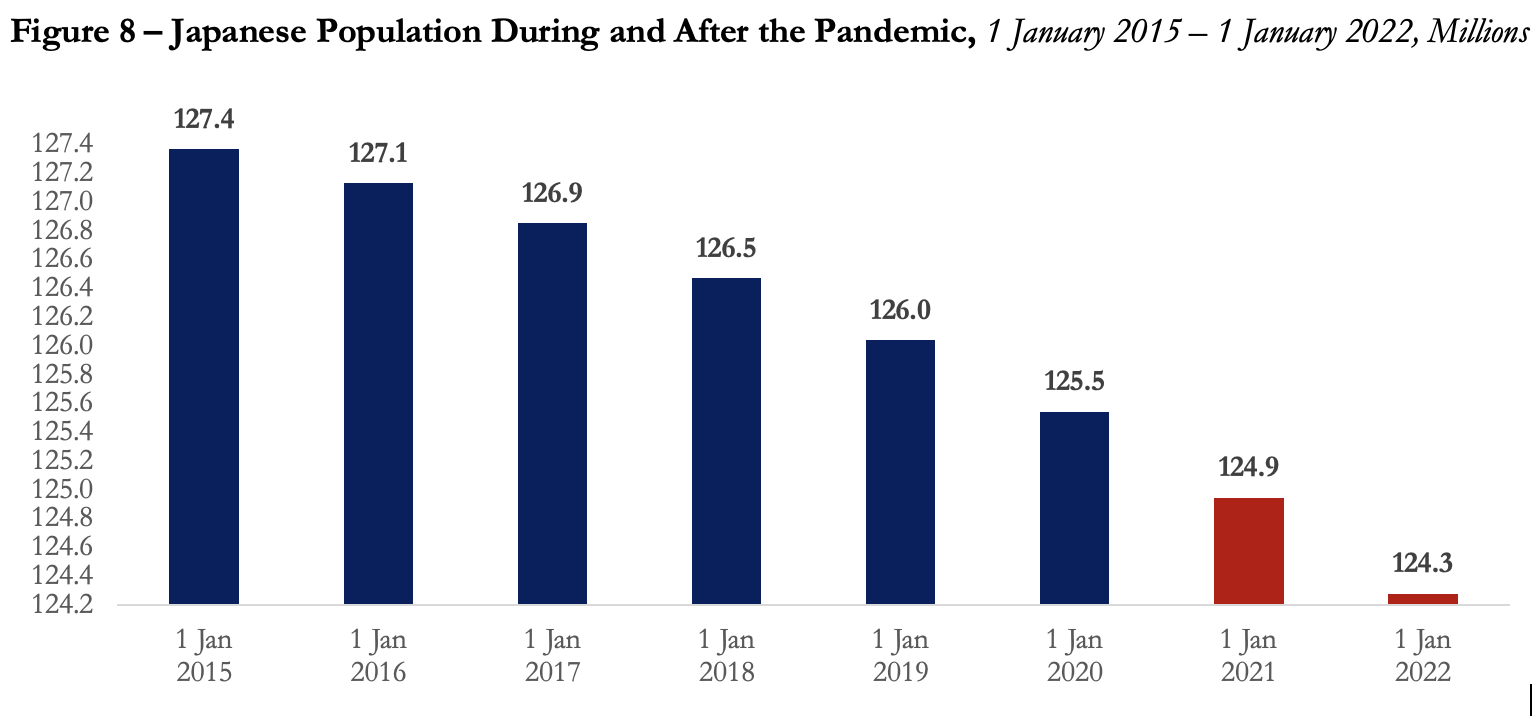
Source: United Nations 2022 World Population Prospects.
Figure 9 presents the components of population change during the pandemic. The number of deaths was particularly high in 2021, recording 1575 thousand, compared to 1519 thousand in 2019. The pandemic’s impact on Japan was further compounded by a decrease in immigration, which had been a critical factor in sustaining the Japanese workforce in recent years. In fact, the pandemic led to a significant reduction in net migration, with the number of net migrants into Japan being cut in half, totaling approximately 88 thousand during the pandemic years, compared to 184 thousand in 2019. Consequently, this resulted in a record-low population decline of 668 thousand in 2021, which is 34% higher than the 2019 value. The lower net migration figures are reflective of the pandemic’s disruption of global mobility, which has affected numerous aspects of life in Japan, including the labor market, family dynamics, and social norms.
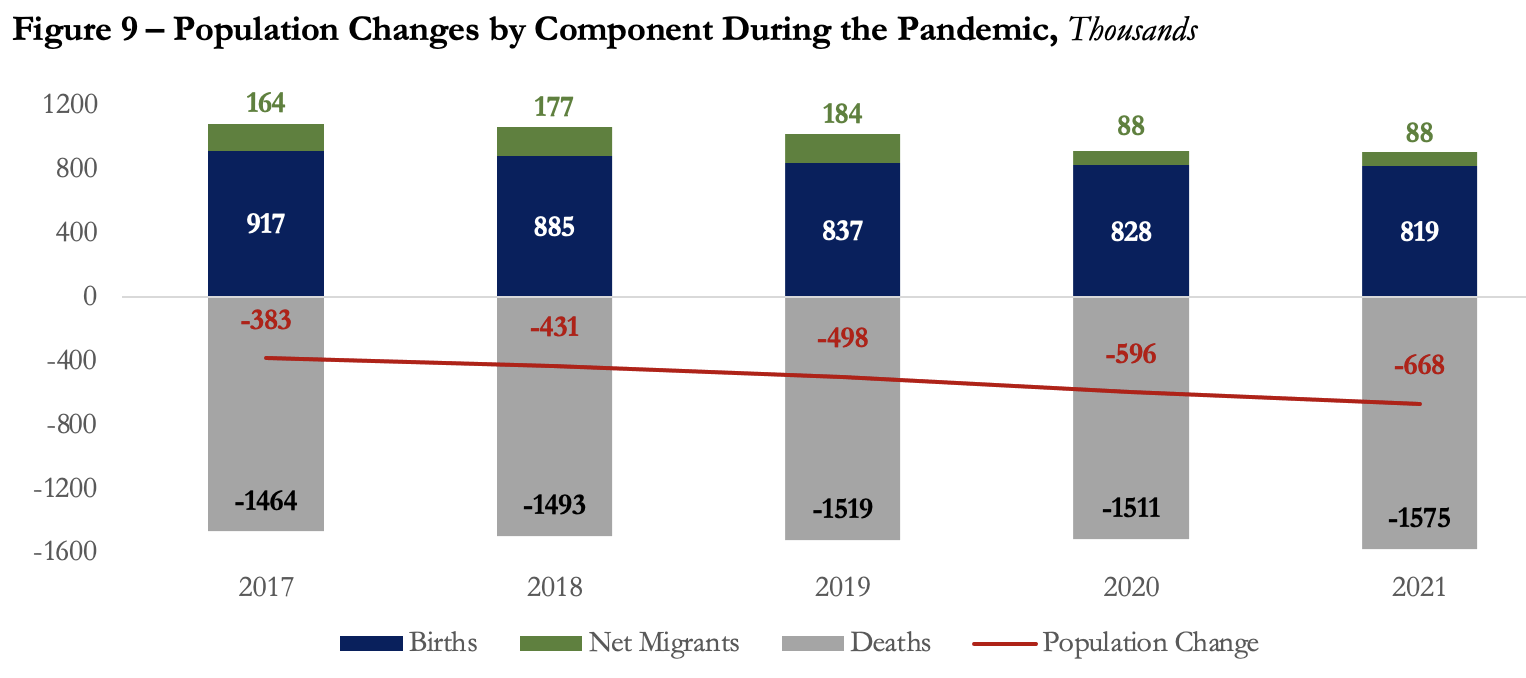
Source: United Nations 2022 World Population Prospects.
How is Japan Different from Other Countries with Shrinking Populations?
In a previous article, we examined the declining population and aging demographics in the EU, and in the following articles of this series, we will continue to look at other countries with shrinking populations. However, Japan’s case is unique and disturbing.
While those countries share the broad demographic trends of shrinking and aging populations, declining birth rates, and increasing life expectancies, Japan’s situation is even more severe due to three distinctive characteristics:
- Japan had a shorter post-war baby boom: While other developed countries had post-war baby booms extending from 9 to 20 years, Japan’s boom lasted for no more than 3 years. Accordingly, the aging and declining population occurred sooner and has been faster than in comparable countries.
- Japan has one of the highest life expectancies in the World: Japan has a life expectancy of 85 years, only second to Hong Kong and Macao, surpassing that of all developed countries. That, coupled with low fertility, exacerbates the demographic shifts and aging process.
- Japan has very low immigration flows: Compared to other developed countries, such as the US or the EU, Japan’s immigration rates are very limited, which exacerbates the situation. For example, in many EU countries with negative natural population change, immigrants have been the only force feeding a positive population growth.
Future Population Demographics: Looking Forward to 2050
Japan is facing a demographic crisis, with an aging population and declining birth rate that has been exacerbated by the COVID-19 pandemic. As shown in Figure 10, the Japanese population has already peaked in the last decade and is expected to continue declining. The population is expected to shrink by a total of 16% between 1 January 2022 and 2050, and by an additional 29% up to 2100, for a total decline of almost 41% in the current century.
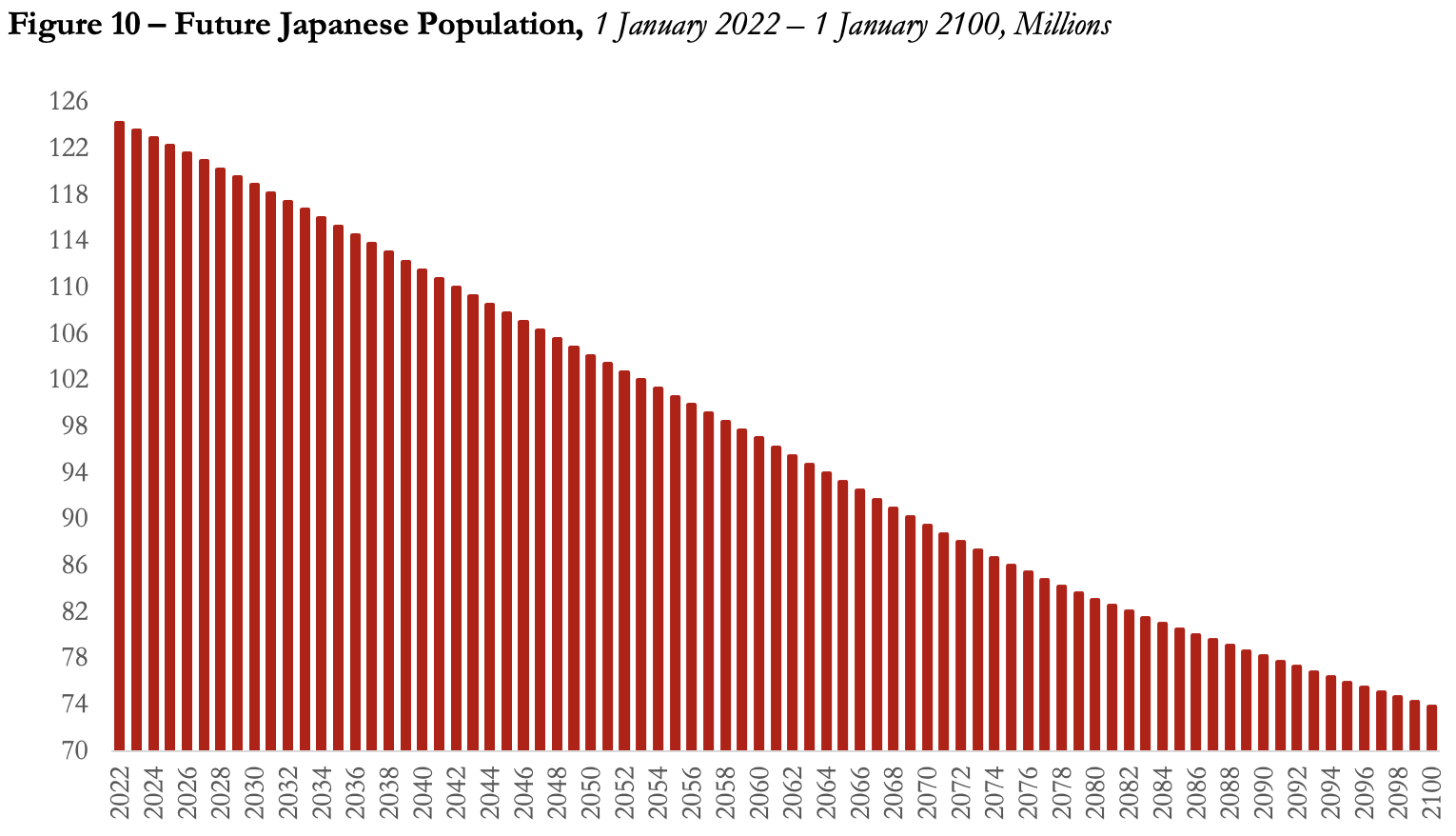
Source: United Nations 2022 World Population Prospects.
According to the United Nations projections, the population is expected to reach 104.1 million in 2050 (1970 level) and 73.8 million in 2100 (even 12% below the 1950 level), compared to 124.3 million in 2022. National projections from the Japanese Statistical Bureau are even more pessimistic, forecasting the population to drop more rapidly, reaching 101.9 million in 2050 (1967 level).
Regardless of the different projections, the story is quite similar. Due to its rapid aging and low birth rate, the Japanese population will shrink in the next 3 decades, and even further by 2100. Figure 11 below presents the Japanese population pyramids for the years 1960, 2019, and 2100. While in 1960 the pyramid had a standard shape characterized by a broad base and a narrow top, this has changed dramatically over the years as the distribution shifted more towards older ages.
The situation will exacerbate further up to 2100. Overall, three main factors are projected to characterize the Japanese population in 2100:
- An Aging Bottom: a decrease in the young-age population due to low births.
- A Shrinking Middle: a considerable shrinkage in the working-age population, increasing their burden to sustain the dependent population.
- A Broadening Top: a large growth in the elderly population, reflecting the aging of the society.
Figure 11 – Japan’s Population Pyramids, 1960, 2019, and 2100, % Total Population

Source: United Nations 2022 World Population Prospects.
Such dynamics are further illustrated in Figure 12 below. The share of the old population, those 65 years of age and above, will reach 38% by 2050 and 39% by 2100. Even worse, the share of the very old population, those 80 years of age and above, will almost double by 2100 to reach 21%, from 10.5% in 2022. Moreover, the median age will be close to 54 years in 2100, with a much higher life expectancy of 94 years.

Source: United Nations 2022 World Population Prospects.
What Does This Mean for the Japanese Economy and Can It Be Mitigated?
A shrinking and aging population is expected to pose multiple challenges for Japan, especially as the working-age population continues to shrink. As shown in Figure 13 below, Japan’s working-age population peaked at 87.1 million in 1994 and has declined by 16.8% since then. The working-age population is expected to decline by an additional 50%, to reach 36.9 million by 2100 compared to 72.5 million in 2022, challenging Japan’s economic activity.
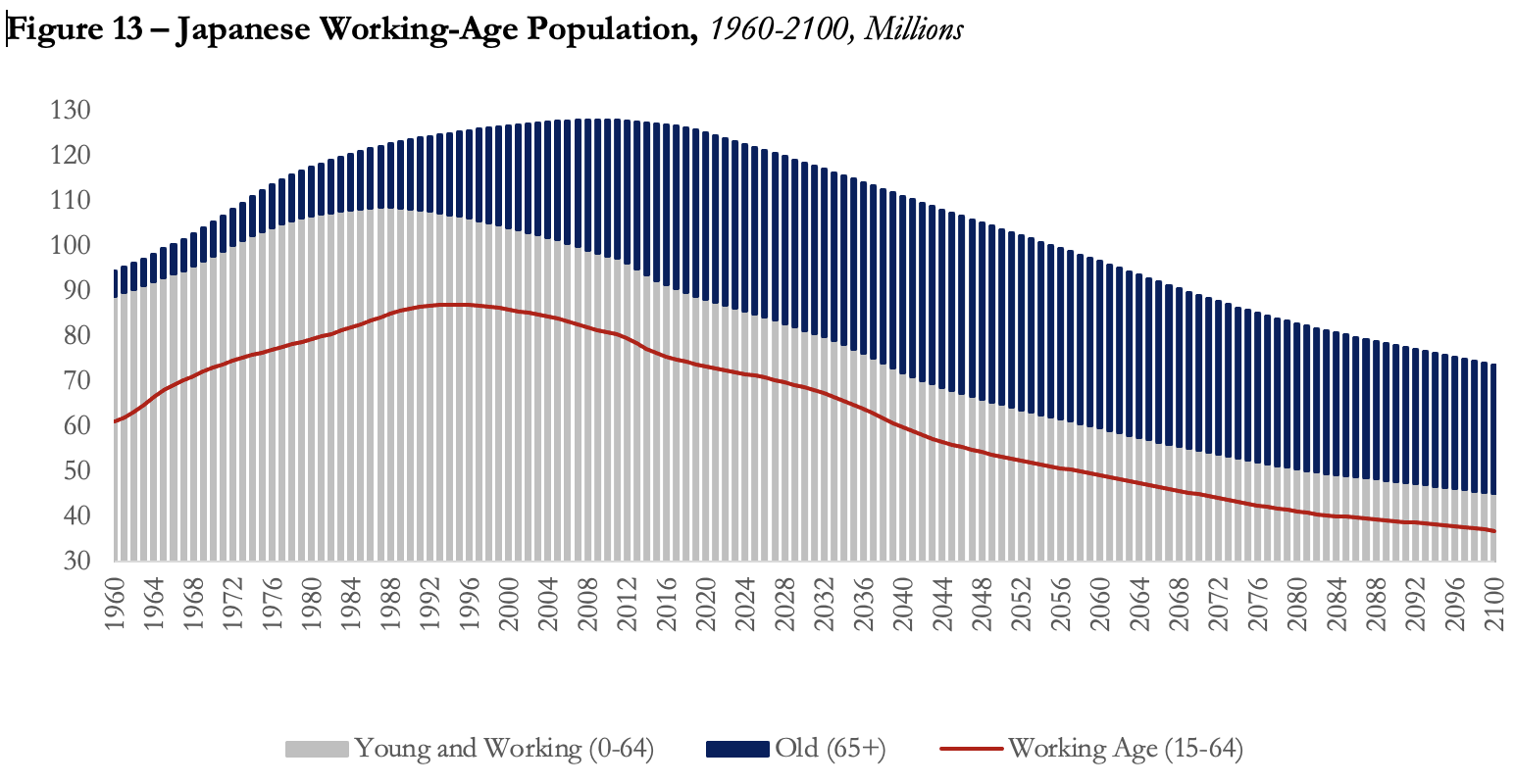
Source: United Nations 2022 World Population Prospects.
This loss of labor force is expected to reduce productivity and exert downward pressure on economic growth. As can be seen in the graph below, the growth trend of Gross Domestic Product (GDP) has historically been largely associated with population growth. Quite Simply, the growth equation is population times productivity. If the population is declining, growth will decline unless there is an offsetting growth in productivity. Without it, GDP will decline. Moreover, an aging population can create larger fiscal burdens on the government. First, as an increasing elderly population becomes dependent on the contributions of fewer workers to sustain these systems, government pension liabilities will need to increase. Second, a higher prevalence of chronic diseases is associated with an increase in the larger number of older people, which will necessitate more public spending on healthcare in general, and on long-term care in specific.
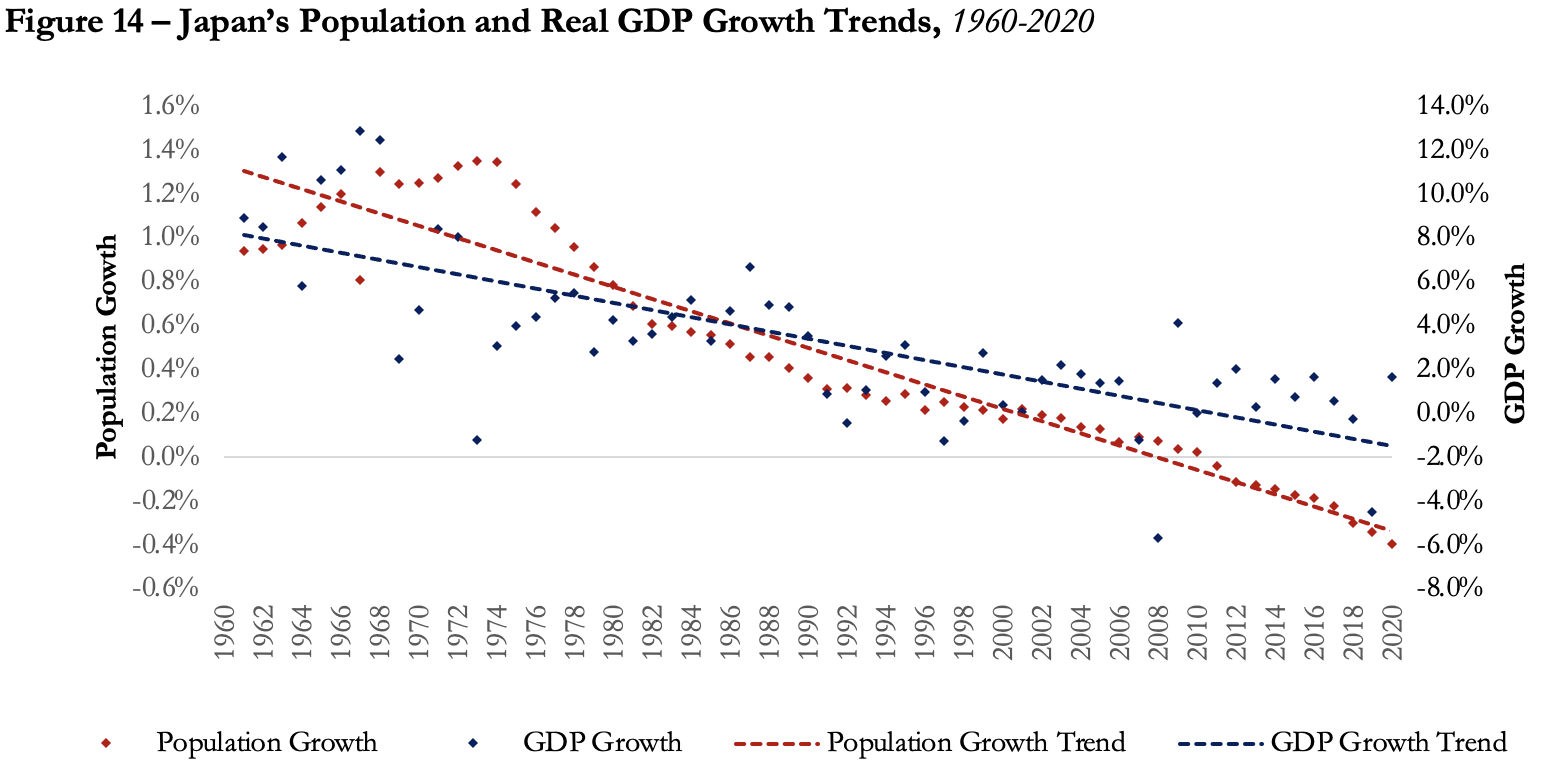
Source: United Nations 2022 World Population Prospects and World Bank’s World Development Indicators.
An appropriate policy mix is essential to address Japan’s demographic challenges, including both structural and economic policies. At the economic level, a mix of monetary and fiscal policies is essential to maintain the proper functioning of the Japanese economy. First, monetary easing should be maintained to support growth and increase inflation to healthy levels. Second, a flexible fiscal policy that stimulates labor market activity while maintaining stability is essential. This includes higher social security contributions or consumption tax to continue financing the increasing pensions, as well as restricting unemployment benefits and more heavily penalizing early retirement (through higher pension cuts) to increase and prolong labor force participation.
At the structural level, labor market reforms to raise labor productivity will be critical in mitigating demographic changes. Those include effective training to increase the labor force skill set and productivity, in addition to the provision of career opportunities to a broader population set, including women and the elderly, to widen the labor force base. In such a sense, providing affordable and accessible child-care facilities and increasing the retirement age will be important. The current retirement age in Japan is 65 years, with a recent law requiring companies to retain workers up to 70 years of age. However, this law is not applicable to contract workers and requires companies with a majority of unionized workers to seek the union’s approval prior to increasing the retirement age. Accordingly, further regulatory changes might be needed to abolish such rights of setting an earlier retirement age.
Radical measures to increase the birth rate might also be necessary, including providing financial support to parents and child health and education expenses. In fact, the Japanese government will reportedly provide a support package including a lump sum baby bonus of 500,000 yen ($3,700) to cover childbirth expenses, in addition to 100,000 yen ($740) to contribute to postnatal expenses, such as diapers, milk formulas, and strollers.
Moreover, given Japan’s low immigration rates, allowing for and encouraging foreign workers can help boost the country’s labor force. One way to increase the availability of foreign labor could be through the encouragement of foreign direct investment in Japan. This will not only promote private investment and economic growth but will also further open the country to foreign and multinational firms, which could bring in and attract skilled labor from external sources.
Ultimately, the ability of the Japanese economy to weather these demographic changes will depend on the country’s ability to remain flexible and innovative in the face of new challenges. The simplest solution, also the most culturally challenging, is to allow more immigration.
Final Thoughts
Japan is facing an unprecedented demographic shift that will have profound implications for its economy, society, and culture. The COVID-19 pandemic has only accelerated the decline in population growth, making it increasingly difficult for Japan to reverse the trend. However, Japan is not alone in facing these challenges, and there are lessons to be learned from other countries that have successfully addressed similar issues. The key to mitigating the impact of Japan’s shrinking population lies in adopting policies and strategies that encourage greater participation in the workforce, support family-friendly policies, and promote immigration. Japan desperately needs to act with concerted efforts today to allow the country to continue to grow and sustain its mammoth debt burden.


